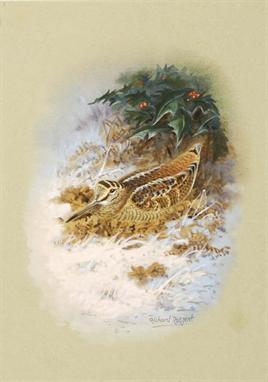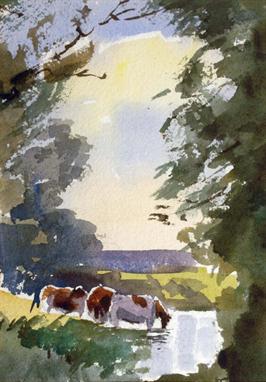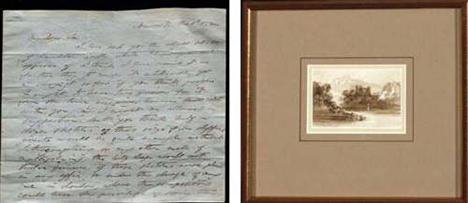We found 32316 price guide item(s) matching your search
There are 32316 lots that match your search criteria. Subscribe now to get instant access to the full price guide service.
Click here to subscribe- List
- Grid
-
32316 item(s)/page
Rickman, Philip. A Bird-Painter's Sketch Book, new edition, Eyre & Spottiswoode, London 1935. Blue-grey cloth with onlaid title label, plate and text illustrations throughout, quarto; Blaugrund, Annette, & Stebbins, Theodore E., editors, John James Audubon: The Watercolours for the Birds of America, first edition, The Herbert Press, New York 1993. Green cloth, dustjacket, illustrations throughout, large quarto; Fleming, C.A. George Edward Lodge: Unpublished Bird Paintings, first edition, Joseph, London 1983. Cloth spined boards, dustjacket, illustrations throughout, large quarto; and assorted other works of ornithological interest, (14).
The Kny Sketch book - A large 19th Century leather bound folio sketch book belonging to glass designer and engraver Frederick Englebert Kny. The book contains sixty five pages of pencil and ink worked illustrations and working drawings for vases, jugs and assorted table ware together with ideas for decorative techniques including engraved and applied work. Contained within the portfolio are a number of loose leaf designs with hand water colour tints. Measures 44cm by 28cm.
after Laurence Stephen Lowry R.A. (1887-1976) "The Beach" signed in pencil, with the blindstamp for the Fine Art Trade Guild, from an edition of 850, published in 1973 by Venture Prints Ltd, Bristol, a colour reproduction, 29cm by 52cm; together with a Facsimile of the Original Pencil Sketch which was issued for the above picture at the time of publication, also from an edition of 850, and bearing the blindstamp for the Fine Art Trade Guild, 17.5cm by 24.5cm, unframed (2) The beach depicted in both drawings is "Deal Beach", the pencil drawing having been produced on the 24th September 1912 the first print is sometimes referred to as "Deal Harbour" or "Seaside" See illustration
attributed to William Henry Hoodless (1841-1902) View of Dumfries on the River Nith with Figures and Animals beside a Stone Bridge bears a signature and dated "1874", oil on canvas, 61cm by 107cm the artist was a landscape painter in oil and watercolour. He visited fellow Cumbrian Samuel Bough in Edinburgh and Bough advised him to enter Edinburgh School of Art where he twice won prizes as a student. He worked mainly in the Lake District and is said to have walked sometimes twenty miles in a day to make a sketch. He is also said to have died following a journey to Caldbeck on foot through deep snow and three days spent sketching in the open air..
John Nixon circa 1750-1818- "A Sketch in the Louvre Gallery, Paris"; pencil with touches of watercolour, signed with initials, extensively inscribed and dated 1814 in pencil, 12.5x17.5cm: together with a group of five pencil and wash drawings of mid 19th century Victorian life, depicting washer women, children playing, the reading lesson, lovers and a coach and horses, all mounted in clip frames, 15x9.5cm (largest), (6)
Pair: Major-General G. Rigaud, 60th Rifles south Africa 1834-53 (Capt., 2nd Bn. 60th Rifles); China 1857-60, 2 clasps, Taku Forts 1860, Pekin 1860 (Major, 2nd Bn. 60th Rl. Rifles), officially impressed naming, edge bruising and contact marks, good fine (2) £600-700 Ex Elson Collection. gibbes Rigaud was born in Richmond, Surrey, the third son of Stephen Peter Rigaud, the Astronomer and Radcliff Observer at Oxford. Commissioned a 2nd Lieutenant in 1841; he was promoted to Lieutenant in 1844 and Captain in 1850. With the 2nd Battalion 60th Rifles he served in the 3rd Kaffir War, 1850-53. Promoted to Major in 1858, he sailed to India in that year and was instrumental in quelling a mutiny which broke out on board the troopship which had become becalmed. He then served in the 2nd China War, for which he was mentioned in despatches and received the brevet of Lieutenant-Colonel. Rigaud was promoted to Colonel in 1868 and attained the rank of Major-General in 1873. Retiring on Full Pay to the City of Oxford, he spent his remaining years writing, and received an honorary degree of M.A. from Oxford University. Amongst his works was Celer et Audax - a history of the 60th Rifles in the Peninsular War. Sold with copied research including an account of the fateful voyage to India in 1858; also with the book Celer et Audax, a Sketch of the Services of the Fifth Battalion Sixtieth Regiment (Rifles), by Major-General Gibbes Rigaud, originally published in 1879, this was a Trotman edition, published in 2002 and limited to 75 copies. £600-£700
Six: Corporal D. A. Read, Royal Corps of Signals, who served in the Raiding Support Regiment 1944-45 1939-45 Star; Africa Star, clasp, 8th Army; Italy Star; France and Germany Star; Defence and War Medals, M.I.D. oak leaf; together with his wartime embroidered parachute wings and related badges (4), among them a cast Badge of the Greek Sacred Legion, the whole contained in a glazed display frame, generally good very fine (11) £300-350 douglas Arnold Read was born in Alverstoke, Hampshire in April 1920 and enlisted in the Royal Corps of Signals at Newport, Isle of Wight, in October 1937, direct from brief service as a Private in the Queen’s Royal Regiment. As verified by accompanying documentation, he served in the B.E.F. from September 1939 until being evacuated in June 1940, and went out to the Middle East in June 1942, in which theatre of war he appears to have been actively employed until the end of hostilities. indeed it is clear from his original Soldier’s Service and Pay Book that he was a qualified parachutist and a member of ‘Raiding Forces’, most probably as a Wireless Operator - he completed No. 1 4 Parachute Course in April 1944, was awarded his ‘operational wings, left breast’ in February 1945, and was further entitled to wear the ‘Badge of the Greek Sacred Regiment’. The same source also confirms that he won a ‘mention’ in June 1945. most probably, therefore, he joined the Raiding Support Regiment (R.S.R.) soon after it was established at the end of 1943, a call for parachute volunteers for ‘duties of a hazardous nature’ gaining around 3,000 applicants from 60 differents regiments and corps. Over the coming months, its members assisted a number of clandestine units in operations in Albania, Greece, Italy and Yugoslavia - in Greece alone its men destroyed 17 bridges, blew up six roads, wrecked hundred of metres of railway line on 18 different occasions, shot up or derailed five trains, blew up five petrol / ammunition dumps, knocked out 150 vehicles, destroyed a dam and killed around 300 of the enemy. read’s entitlement to wear the Badge of the Greek Sacred Regiment, a sister unit, is not without interest, for the R.S.R’s ‘Foxforce’ became embroiled in the Greek Civil War 1944-45, the British losing 250 troops in five weeks of bitter fighting against E.L.A.S. Discharged to the Army Reserve in the rank of Corporal in June 1946, he was serving as an Acting Warrant Officer in the 5th (Cadet) Battalion, Suffolk Regiment in the mid-1950s. sold with a quantity of original documentation, including the recipient’s Soldier’s Service and Pay Book, Regular Army Certificate of Service, a sketch book, a wartime field message form, with pencilled statement in a foreign language (‘If liable to be intercepted or to fall into enemy hands, this message must be sent in cipher ... ‘), and a calendar booklet for 1941-42, which includes a list of officers Read was appointed to train in Morse and wireless operation, suggesting perhaps even earlier participation in clandestine operations. £300-£350
Three: Sergeant J. F. J. Drummond, 1st Battalion, East Kent Regiment, sometime cartoon sketch artist for the regimental magazine, The Dragon 1914 Star, with clasp (L-5204 Pte., 1/E. Kent R.); British War and Victory Medals (L-5204 Sjt., E. Kent R.); together with memorial plaque (John Francis Joseph Drummond) nearly extremely fine (4) £200-250 John Francis Joseph Drummond was born in Aberdeen, Scotland and lived at Richmond, Surrey. He was killed in action in France and Flanders on 20 April 1917 whilst serving with the 1st Battalion, East Kent Regiment. sold together with a quantity of original documentation, including four copies of The Dragon regimental magazine, which include various cartoon sketches drawn by Drummond; two of his sketch books; account book; and a number of photographs of recipient, including one of his original grave marker. £200-£250
James Bateman (1893-1959) - Oil sketch - “Study for Harvest” - Country scene with horsedrawn harvesters and numerous figures, board 16.5ins x 21.5ins, signed and inscribed in red, and labelled to reverse, in modern painted frame Note : Main oil painting exhibited at the Royal Academy in 1934 (and two press cuttings contained in envelope to rear of picture)
Peter Cushing (1913-1994) - Watercolour - “Spain - Watercolour sketch from an Edward Seago Oil” - Street scene with seated figure and donkey, 5.75ins x 7.25ins, inscribed, signed with initials and dated VII ‘93, and personal inscription “To welcome Dear Awed and Bee back from their Crete hols”, in modern moulded frame and glazed
Peter Cushing (1913-1994) - Watercolour - “Watercolour sketch of a detail from an oil painting by Edward Seago” - Landscape with cattle watering, 9.5ins x 6.5ins, unsigned but inscribed in Peter Cushing’s hand on label to reverse, signed with initials and dated ‘90, in limed oak frame and glazed
Horace Shipp - “Edward Seago - Painter in the English Tradition”, published by Collins, London 1952 (one volume in blue cloth binding), inscribed on fly leaf as a personal gift to Peter Cushing by Edward Seago - “To my ever dear Watson with every mark of affection and esteem from his guide and friend Sherlock, Baker Street, July 1900”, with small sketch of Sherlock Holmes wearing a deerstalker and a violin, also inscribed “The Dutch House, July 1958), bears the library stamp of Peter Cushing and remnants of paper dustcover, and two handwritten letters from Edward Seago, one on headed notepaper, “The Dutch House, Ludham, Norfolk” and dated 1.64, addressed to “Dear Helen”, the other addressed to “Dearest Peter and Helen” and dated 30th December 1964
Kenneth Newton (1933-1984) - Two - Pencil and charcoal sketch - Still life with kettle and oil lamp (unfinished), 8ins x 11ins, and three sketches with study of “Eleanor” to reverse, unsigned, and a charcoal half length sketch of “Eleanor”, 12ins x 7.25ins, unsigned (both mounted but unframed)
Wilfred G. May, pastel sketch of a girl with blonde hair in suspenders, unsigned, circa 1940, and five others W. G. MAY 1922 -. , (Wilfred Glyndon May BSc FICE) W. G. May is a self-taught watercolourist who also works sometimes in pastels, crayons or oils. His greatest influence is Sir W. Russell Flint, of whose technique he has made a lifelong study. Russell Flint's fluid watercolours and exotic nudes inspire many of May's nude figure paintings, but the artist also specializes in clothed figures - particularly female dancers - and portraits. The occasional flower study, landscape or still life also finds a place among his work. May attained his Civil Engineering degree at University College, London in 1943, after which he became an officer in the Royal Engineers for the remainder of the Second World War, stationed in North Africa. He then worked for the WS Atkins Group until 1981, when he retired in order to become a full-time artist. He has exhibited in galleries in the Epsom and Dorking area, and served for several years as Chairman of the Epsom Art Group, whose exhibitions are held at Bourne Hall, Ewell. In his home village of Tadworth he has been influential in the amateur art world, as an inspirational art tutor and leader of outdoor painting expeditions. W. G. May continues as an art tutor, but gave up his own painting career two years ago due to illness. Most of his earlier work has been sold. What remains is pieces of work never before offered for sale, and some from recent years. h: 14 x w: 12 in.
Wilfred G. May, oil, portrait of a ballerina in black tutu, 20" x 14", with a preliminary sketch, 12" x 9" W. G. MAY 1922 -. , (Wilfred Glyndon May BSc FICE) W. G. May is a self-taught watercolourist who also works sometimes in pastels, crayons or oils. His greatest influence is Sir W. Russell Flint, of whose technique he has made a lifelong study. Russell Flint's fluid watercolours and exotic nudes inspire many of May's nude figure paintings, but the artist also specializes in clothed figures - particularly female dancers - and portraits. The occasional flower study, landscape or still life also finds a place among his work. May attained his Civil Engineering degree at University College, London in 1943, after which he became an officer in the Royal Engineers for the remainder of the Second World War, stationed in North Africa. He then worked for the WS Atkins Group until 1981, when he retired in order to become a full-time artist. He has exhibited in galleries in the Epsom and Dorking area, and served for several years as Chairman of the Epsom Art Group, whose exhibitions are held at Bourne Hall, Ewell. In his home village of Tadworth he has been influential in the amateur art world, as an inspirational art tutor and leader of outdoor painting expeditions. W. G. May continues as an art tutor, but gave up his own painting career two years ago due to illness. Most of his earlier work has been sold. What remains is pieces of work never before offered for sale, and some from recent years.
Toer van Schayk, Dutch mid 20th century- Sketch for a staged photography for the ballet 'Monument for a Dead Boy'; pen and black ink and collage, signed, inscribed and dated 66, on irregular shaped piece of tissue thin paper now laid down, 36x34cm. Note: This ballet, chorography and libretto by van Dantzig, 1965 was the first 'modern' ballet role offered to the Russian dancer Rudolf Nureyev, 1938-1993
Circle of Alexander Cozens, c.1717-1786- Fortified ruins in an Italianate landscape; black ink and traces of pencil on buff paper, bears signature (lower left) within the original wash line mount; 18x28.8cm and one other pencil on buff paper study depicting an Italianate landscape, by the same hand, bears signature (lower left) within the wash line mount: together with twelve pen and black ink vignettes, depicting views in Italy possibly by the same hand and an album of further 18/19th century watercolour, pen and black ink, European topographical studies by various hands mostly common mounted within a marble boarded album, mostly depicting Italianate views, on various laid papers, (all mounted on loose sheets originally bound within an album A/F) (unframed) Note: Alexander Cozens visited Italy in 1746, where he executed topographical drawings most noticeably for inclusion in the Roman Sketch book; (see Yale Centre for British Art, Paul Mellon Collections "A Roman Sketch Book by Alexander Cozens")
Circle of John "Warwick" Smith 1749-1831- View from a wooded Crag towards a distant lake and ruins; watercolour, 33.9x48cm: English school early 19th century- "View of Coventry"; signed and dated Tudor Norman(sic), Oct 9, 1805: Follower of John Constable 1776-1837- Study of trees; oil sketch on paper, together with one other pencil sketch depicting figures by a cottage by a different hand, (4) (unframed)
Fuller, Edmund George (1858-1940) - Small quantity of items relating to Fuller and St Ives including photograph of Fuller, pen and ink advertisement ‘Edmund.G. Fuller, Artist, Saint Ives, Cornwall’, pen and ink drawing of St Ives, original art work for Borough of St Ives Elementary Schools Swimming Association, sketch book, and note books etc
-
32316 item(s)/page





















![Henry John Boddington RBA (1811-1865) 'On the Mawdack [sic] North Wales - a sketch from nature' oil on board, signed, inscri](http://lot-images.atgmedia.com/SR/15438/2730567/269-28-15438_468x382.jpg)


























